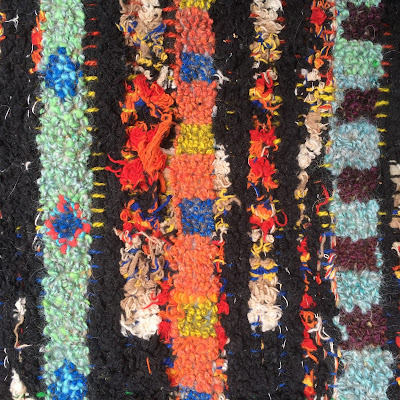The rugs are of similar size (about 23" x 42") but each one weighs more than the last. (2 lb, 11 oz; 1 lb, 9 oz; and 1 lb, 2 oz). The differences in weight come from compressing the weft more and more with each weaving.
 |
| A series of woven fleece rugs - the most recent, heaviest one is on the left. The lightest one, woven on a harness loom, is on the far right. The latter weighs a great deal less than the other two. |
"Skirting" is a term for removing undesirable locks from a nice fleece before selling it. Skirted locks are too short, too crimpy, too coarse, or otherwise unsuitable for serious spinning. For my rugs, however, skirted locks are useful. Since I'm not spinning them (but, rather, rolling them into "snakes"), length and uniformity are not an issue.
A "batt" is a sheet of carded fiber that comes off the drum carder. My batts weigh between 1 and 2 ounces each. The carder aligns the fibers for easy drafting. Carding is also a quick way to blend several colors. One pass through the carder gives a variegated look. Several passes would give a smooth blend.
 |
| 1 and 3/4 ounce batt of brown and white fibers, mixed |
The carded batt can be torn into strips which can then be drafted into a "snake," the rope-like ball of drafted fiber seen below. It takes about 20 minutes to produce an 8 yard, 1 3/4 ounce "snake" from a carded batt.
 |
| The 8 yard snake has been compressed by rolling loose batting between my hands. No water required! Not quite felt, but sturdy enough to weave into a pre-felt rug. |
From about 3 dozen of these unspun, pre-felt snakes, I can weave a fleece rug. I made the first one on a harness loom. (See the lightweight rug with the brightly colored fringe in the picture at the top of the page.) I wove the other two rugs on a peg loom, shown below. You wind the snakes around the pegs, then pull the warp through the weft.
 |
| On a peg loom, the weft (the horizontal element of a weaving) slides down the warp (vertical element) as weaving progresses. |
The last stage of rug making will be to put the rug in the bathtub, add soapy water, and walk on it until tired. (I've tried skipping the wet-felting stage, but the weft tends to "halo." Loose ends of fiber stick out all over the rug.) Wet felting helps the fibers stay flat on the rug, even when subjected to plenty of foot traffic.





